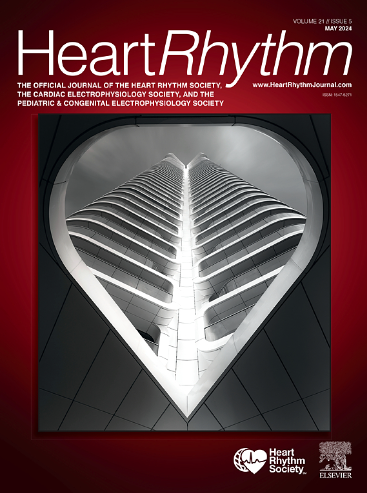In search of a driver for atrial fibrillation
IF 5.7
2区 医学
Q1 CARDIAC & CARDIOVASCULAR SYSTEMS
引用次数: 0
Abstract
Background
Short atrial fibrillation cycle lengths (AFCLs) and regular activation patterns are associated with drivers of atrial fibrillation, although the relation with underlying patterns of activation is incompletely understood. Previous studies used automated assessment of electrograms to determine fast and regular fibrillatory rates.
Objective
We investigated the relation among AFCL, temporal variation in AFCL, and the occurrence of driver-like patterns of activation using high-density local activation time mapping.
Methods
High-density epicardial mapping of the right atrium and left atrial ventricular groove including Bachmann’s bundle was performed in 71 patients admitted for elective cardiac surgery. Recording sites with the shortest median AFCL or the smallest standard deviation of AFCL were identified. Patterns of activation included focal or rotational activation, smooth propagation, propagation with conduction block (CB), collision, and remnant activity.
Results
There was a higher number of fibrillation waves with CB (81% [interquartile range (IQR) 76%–85%] vs 74% [68%–76%]; P < .001) and fractionated potentials (22% [12%–37%] vs 12% [9%–15%]; P < .001) at shortest median AFCL than at other recording sites. Smallest standard deviation sites harbored more smoothly propagating waves (33% [24%–54%] vs 17% [11%–25%]; P < .001) and a higher proportion of single potentials (76% [60%–89%] vs 59% [54%–65%]; P < .001). Both highly regular and fastest reactivated sites did not correspond to the origin of (repetitive) focal fibrillation waves.
Conclusion
During extensive mapping, the fastest or most regularly activated areas are characterized by CB and smoothly propagating fibrillation waves instead of repetitive occurrence of focal or rotational activation patterns. This study rejects the concept of detecting drivers by identifying the fastest or most regularly activated recording sites.
寻找心房纤颤的司机。
背景:短的心房颤动周期长度(AFCL)和规律的激活模式与心房颤动(AF)的驱动因素有关,尽管与潜在的激活模式的关系尚不完全清楚。以前的研究使用自动评估心电图来确定快速和正常的心律。目的:利用高密度局部激活时间图研究AFCL、AFCL的时间变化与驱动样激活模式的关系。方法:对71例择期心脏手术患者行右心房、左房室沟(包括巴赫曼束)高密度心外膜标测。确定AFCL中位数最短(mAFCLmin)或AFCL标准差最小(SDmin)的记录位点。激活模式包括聚焦或旋转激活、平滑传播、传导阻滞传播、碰撞和残余活动。结果:与其他记录部位相比,心房纤颤波数较多(81[76-85]% vs 74[68-76]%)。结论:在广泛的作图过程中,激活最快或最规律的区域以CB和平滑传播的颤动波为特征,而不是重复出现的焦点或旋转激活模式。
本文章由计算机程序翻译,如有差异,请以英文原文为准。
求助全文
约1分钟内获得全文
求助全文
来源期刊

Heart rhythm
医学-心血管系统
CiteScore
10.50
自引率
5.50%
发文量
1465
审稿时长
24 days
期刊介绍:
HeartRhythm, the official Journal of the Heart Rhythm Society and the Cardiac Electrophysiology Society, is a unique journal for fundamental discovery and clinical applicability.
HeartRhythm integrates the entire cardiac electrophysiology (EP) community from basic and clinical academic researchers, private practitioners, engineers, allied professionals, industry, and trainees, all of whom are vital and interdependent members of our EP community.
The Heart Rhythm Society is the international leader in science, education, and advocacy for cardiac arrhythmia professionals and patients, and the primary information resource on heart rhythm disorders. Its mission is to improve the care of patients by promoting research, education, and optimal health care policies and standards.
 求助内容:
求助内容: 应助结果提醒方式:
应助结果提醒方式:


